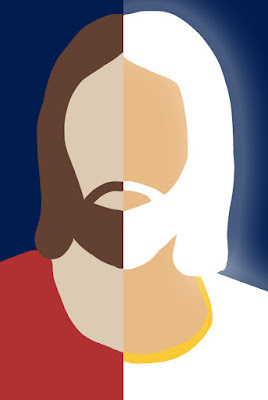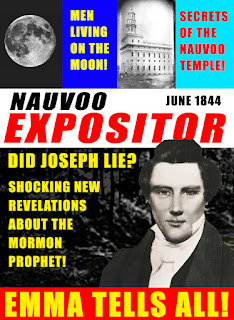Learning from Jesus' Hair
This is not going to be about Jesus’ race or skin color or anything like that. I will be talking about His hair color from the perspective of the common paintings of Him. I will refer to it is brown, because it will make the whole experience easier. If you want to tell me how wrong I am about his hair, feel free but I don’t really care. That’s not what this post is about. Also, major disclaimer: don't take any of this too seriously. I have recently been called "passive-aggressive," a "belligerent ignoramus," a troll, and a great many other things that would not bear repeating in polite company. My advice to the people that get triggered by the ramblings of a nerdy young man with crazy ideas is to take a deep breath and loosen up a little. Have some fun! Or just don't read it. That's always an option.
The Resurrected Christ is depicted with white hair in some pictures and brown in others. For example, He appears to the Nephites with brown hair in all of the paintings, but the Bible clearly says that John the Revelator saw Him with white hair. Is this an inconsistency between the Bible and Book of Mormon that can torpedo the entire religion?
As usual, it is not. First of all, artistic renditions are not doctrine. Just because an artist paints Jesus with brown hair among the Nephites does not mean he had brown hair. This seems obvious but I have seen people attempting to attack doctrine based on pictures, the religious equivalent of equating a person's physical looks with their intelligence. That's something only a stupid and unattractive person would do, but I digress. To me the color of the hair itself doesn’t matter, it is the difference that I find interesting. I feel that the artists were conveying a doctrinal concept through the differences in hair color. I first thought of this when I realized that Christ’s appearance to the Nephites never shows Him with white hair. My initial joking thought was that it had been bleached by the light of the Celestial Kingdom. That’s why later appearances to John the Revelator and Joseph Smith have a white-haired Messiah. While that’s pretty ridiculous, it actually sowed the seed that would lead me to the answer.
By having brown and white-haired versions of Christ, the various artists are depicting the difference between the degrees of glory. Per section 76 of the Doctrine and Covenants, Christ can dwell in celestial or terrestrial glory. The artists depict Him with white hair as a celestial Being and brown as a terrestrial Being. This possibility lead me to another major realization, the Book of Mormon shows evidence of the three degrees of glory despite being published years prior to the revelation that describes and names them. So either Joseph Smith had that planned out from the very start and provided meticulous detail in the Book of Mormon (that would incidentally be supported by Biblical evidence as well) in order to build a credible foundation on which he could “reveal” the degrees of glory or he and other divinely inspired men have been writing about the same things for centuries and the similarities in their writings are indicative of unchanging truth. In other words, the divinity is in the details.
As for evidence, there’s undoubtedly a ton that I am missing and would love it for people to sound off in the comments or with messages to me with more as they find it. That being said, the crux of this whole thing goes back to Christ appearing to the Nephites. This theory assumes that at any point in time a person living on Earth will fall into one of the three degrees of glory based on their personal righteousness and they will only receive manifestations from God, Christ, or angels that fit into those degrees. When Christ comes he destroys the wicked (telestial), ministers to the righteous of different denominations (terrestrial), and ministers in a pillar of fire to the purest among them (celestial). Awfully convenient that this just so happens to align perfectly with the revelation published two years later, but that is to be expected of a religion in which the doctrine doesn't change every five minutes even if policies and applications of the doctrine may change based on the needs of the people. This is also a prototype for the Millenium. I don't know how much had been revealed about the Millenium by the time the Book of Mormon was published, but my guess is there wasn't a lot. In other words, this could be another case of a doctrinally consistent Easter egg appearing before the revelation that discusses and names it.
When these divisions became clear to me I realized just how deeply ingrained the degrees of glory are in all books of scripture. If my theory holds true, every missive from God should follow this pattern. And so far I have not found one that does not. John the Revelator saw the glorified Christ. He had white hair and was divine in every sense of the word. Thomas saw a terrestrial version of Christ whose presence was not so apparently glorious, but who still only appeared in the presence of his disciples. The difference being that John was at a celestial level of obedience or faith or whatever you want to call it and Thomas, though faithful, had his doubts that Christ had returned making him a terrestrial candidate at the time. They were also in a closed room where the only people inside were disciples and Christ showed them sēmeion which couldn't be recorded for some reason. I'll let you piece that together (this is a link to that scripture with a word by word breakdown in Greek if you are wondering where this came from).
“What about Saul!?!” the detractors may cry. Great question. Christ never appeared to Saul. His voice came to Saul and there was a very bright light, but there is no indication that the glorified body of Christ inhabited the same physical space as Saul. After Saul became Paul, he saw celestial glory, which he refers to as the third heaven, and writes about the division of celestial and terrestrial bodies going so far as to discuss a better resurrection which you can read more about here. If anything, Saul’s experience enhances my theory because it shows a consistency in the way Christ manifests Himself.
This same pattern is at work with Joseph Smith. He received angelic visitations until he was repentant of his follies. At that point the celestialized Christ appeared alongside the always celestial Father to provide Joseph Smith with the message of the Restoration. And again in the Book of Mormon we see the pattern. Lehi likens the glory of Christ in his first recorded vision to that of the sun and the glory of the apostles to that of the stars. Not to mention Jacob’s ladder (implying gradation), the three divisions of the Tabernacle, the transfiguration of a bunch of prophets in both the Bible and LDS scripture, the fact that Christ never appears to the unrighteous after His resurrection (find an example if you can), the eyewitness accounts of the Kirtland Temple dedication, my theorized de-translation of Moses and Elijah, the talk of exaltation and gods in the scriptures, and probably a whole bunch of other stuff I’m missing.
Not even Marvel movies are this consistent with their Easter eggs and references. I mean people were losing their minds when they noticed a prototype of Captain America's shield among Tony Stark’s stuff in Iron Man, but this is next level obsessive detail. What do you think though? Are these just the ramblings of a person with an overactive imagination that’s over thinking things? Am I way off base? Perhaps I'm just being a belligerent ignoramus. If so, can you find me something scriptural that pokes a hole in this? I’d be interested to read it. Either way, I never thought that asking about Christ’s inconsistent hair color would get me to this point. With a little imagination and study you'd be surprised at the things you can come up with.





Comments
Post a Comment